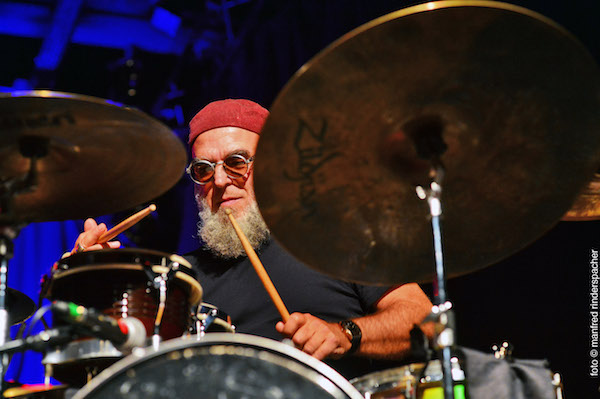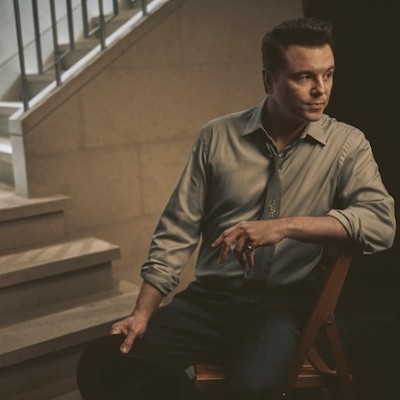Dec 9, 2025 12:28 PM
In Memoriam: Gordon Goodwin, 1954–2025
Gordon Goodwin, an award-winning saxophonist, pianist, bandleader, composer and arranger, died Dec. 8 in Los Angeles.…

Erwin Ditzner performs at the 2017 Enjoy Jazz Festival in Mannheim, Germany.
(Photo: Manfred Rinderspacher)Some festivals cram everything into a single weekend, but Enjoy Jazz, in the southwest of Germany, is an epic affair whose 19th edition ran Oct. 1–Nov. 11 this year. There are one or two concerts each evening, divided between three reasonably proximate cities: Mannheim, Ludwigshafen and Heidelberg.
Although springing from a jazz source, Enjoy Jazz includes a well-chosen selection of satellite acts, including Oren Ambarchi, Gonjasufi and Lapalux. Its jazz reach is also broad, embracing artists such as Archie Shepp, Vijay Iyer, BadBadNotGood and the Hot 8 Brass Band. Much of this good taste emanates directly from festival director Rainer Kern.
Many of Enjoy Jazz artists are international visitors, but one of the most impressive concerts witnessed while DownBeat was in town featured local drummer Erwin Ditzner and his Carte Blanche band. They appeared in Alte Feuerwache, Mannheim (Oct. 23), which is a converted old fire station, boasting a fine acoustic and a still-intact interior. Ditzner has the honor of being the artist who has played the most times at Enjoy Jazz, on this occasion bringing along Aki Takase (piano), Silke Eberhard (reeds) and Sebastian Gramss (bass). The set opened with a lengthy improvisation of around 50 minutes, Ditzner crafting a free-floating small gong shimmer on his small drum kit, until Takase and Eberhard released rapid-fire figures that grew in spikiness.
Ditzner likes to pull out extra objects from his kit-bag, placing them around his skins to create an alternative sound cradle. A chamber stillness ensued, as Gramss bowed his upright bass and Ditzner scraped his cymbals, having also set a pair of bongos on his snare, pushing one of his drumsticks down vertically to make a tinny North African darbouka-like attack. He maintained a shuffling detail, working with small cymbals on his skins.
A trio section evolved, without Eberhard, as Takase took over, in a highly agile Cecil Taylor mode, the saxophone returning as Ditzner placed a large cymbal on his snare-head. Gramss deployed a pair of bows on his bass, and Eberhard switched to clarinet. Takase worked inside her piano, and all band members cooperated in a sonorous drone-field. She prepared her piano, not least with a selection of small squeaky toys, Takase being well-versed in the inclusion of humor and absurdity in improvisation, hammering on the low keys, climaxing then beginning afresh, with a smattering of small sounds.
The second number had a pre-planned method, as each quartet member initiated improvisation via eloquent gesturing, inviting the other three players to respond to their body language. This practice circled around all four members, rotating several times, allowing some guidance in the spontaneity. Takase upended a basket of ping-pong balls into her piano, sending them popping into the air as she hurtled up and down the keys.
This manic capering spread to the entire band, with Eberhard delivering a sepia-toned tenor solo, all four players turning to a sequence of hand percussion on all fronts, Ditzner rattling his bongos with manic enthusiasm. The set had flown from deeply sensitive atmospheres into clowning extroversion, all moods covered with absolute finesse.
Three days earlier (Oct. 20), the Wolfgang Muthspiel Quintet appeared at the lavish white-and-gold Rokokotheater in Schwetzinger, completed in 1753. This smaller city, not far from Mannheim, has now become involved with Enjoy Jazz, and will be continuing to present concerts in next year’s program. The Austrian Muthspiel was touring with his U.S. associates: Ralph Alessi (trumpet), Jon Cowherd (piano), Scott Colley (bass) and Eric Harland (drums).
The group’s compositional approach is one of lyricism and smoothness, with “Triad Song” finding most of the band working towards a luminous unity rather than offering an individualist bite. The main exception was Alessi, whose solos frequently pushed each song toward a fiery direction. Muthspiel’s electric guitar tone is an amalgamation of stylists who have co-opted elements of soft rock, such as Pat Metheny and Mike Stern. His tone sounded preferable when playing acoustic guitar, imparting a more individual texture to the solo lines, a gentle snap of taut strings audible throughout. Harland also livened up the proceedings with a few drum solo outbreaks, striking lightly and making slashed cymbal scrapes.
Mannheim is a city with an abundance of swanky shopping centers, and it was in one of these that Norwegian pianist Bugge Wesseltoft gave a solo recital on Oct. 19. The Engelhorn center arranged chairs amid its clothing and jewelry sections, serving drinks and gourmet burgers before the performance. Even so, the bustling social occasion settled down into a very concentrated listening session, as Wesseltoft operated at sometimes extremely quiet levels.
He was celebrating the release of Everybody Loves Angels, which selects classic songs from the pianist’s growing-up years. Despite the risk of being a sophisticated lounge player, Wesseltoft took these songs along a path of deconstruction and rebirth, their identity sometimes only apparent after a few verses. He made a quarter-speed prance, with a spaced-out swaying motion, zooming in on the collective concentration. A faint hymnal quality pervaded the shopping center, similar to that created by fellow Norwegian pianist Tord Gustavsen.
When Wesseltoft revealed “Bridge Over Troubled Water,” he became the most sophisticated lounge pianist in town, having a heightened control over the dynamics, miraculously unhurried, and imposing a radical effect on the after-hours commercial zone, witnessed as few have ever experienced this environment.
The slow probing of Wesseltoft’s interior state continued with “Angel” (Jimi Hendrix), “Morning Has Broken” (Cat Stevens) and “Blowing In The Wind” (Bob Dylan). There was a suspension of conventional climaxing, as Wesseltoft teased out the melodies with caressing hints, concluding with “Let It Be” (the Beatles) and encoring with “Moon River” (Henry Mancini). If he’s not careful, Wesseltoft could devote his entire career to such appearances, in massive contrast to his other incarnation as a crazed electronicist. DB

Goodwin was one of the most acclaimed, successful and influential jazz musicians of his generation.
Dec 9, 2025 12:28 PM
Gordon Goodwin, an award-winning saxophonist, pianist, bandleader, composer and arranger, died Dec. 8 in Los Angeles.…

Flea has returned to his first instrument — the trumpet — and assembled a dream band of jazz musicians to record a new album.
Dec 2, 2025 2:01 AM
After a nearly five-decade career as one of his generation’s defining rock bassists, Flea has returned to his first…

“It’s a pleasure and an honor to interpret the music of Oscar Peterson in his native city,” said Jim Doxas in regard to celebrating the Canadian legend. “He traveled the world, but never forgot Montreal.”
Nov 18, 2025 12:16 PM
In the pantheon of jazz luminaries, few shine as brightly, or swing as hard, as Oscar Peterson. A century ago, a…

Dec 11, 2025 11:00 AM
DownBeat presents a complete list of the 4-, 4½- and 5-star albums from 2025 in one convenient package. It’s a great…

Seth MacFarlane takes a turn from his television and film career to sing arrangements made for Frank Sinatra, but never recorded.
Nov 18, 2025 12:04 PM
“I’m not gonna lie to you — I don’t know why I thought this was about The Naked Gun, but I’m happy it’s…